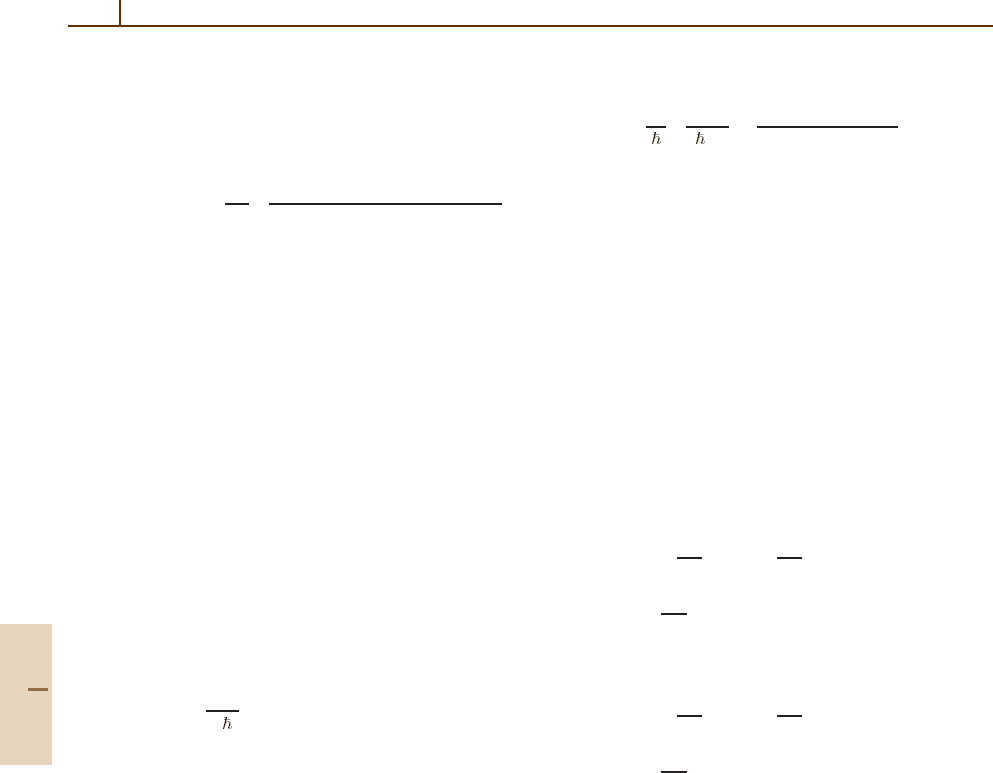Drake G.W.F. (editor) Handbook of Atomic, Molecular, and Optical Physics
Подождите немного. Документ загружается.


Absorption and Gain Spectra 69.5 Two-Level Doppler-Free Spectroscopy 1015
unity with a positive slope. This is called anomalous
dispersion and signifies the presence of a gain profile.
In such a medium, α
=Im[α(ω)]is of opposite sign, as
seen from (69.47); in the inverted medium, α
becomes
negative near ∆ = 0. From (69.2), this indicates a grow-
ing electromagnetic field, i. e., an amplifying medium.
The amplitude grows, and the assumption of a small
signal becomes invalid. Then saturation has to be in-
cluded, either at the rate equation level or by performing
a full density matrix calculation. This regime describes
a laser with saturated gain. In steady state, the two lev-
els become nearly equally populated (ρ
ee
≈ρ
gg
), and the
operation is stable. The theory of the laser is discussed
in detail in Chapt. 70.
69.5 Two-Level Doppler-Free Spectroscopy
The linear absorption of a scanned laser signal
defines linear spectroscopy and gives information char-
acterizing the sample. However, Sect. 69.3 shows that
inhomogeneous broadening masks the desired informa-
tion by dominating the line shape. The availability of
laser sources has made it possible to overcome this limi-
tation, and to use the saturation properties of the medium
to perform nonlinear spectroscopy. This section dis-
cusses how Doppler broadening can be eliminated to
achieve Doppler-free spectroscopy. Similar techniques
may be used to overcome other types of inhomogeneous
line broadening; a general name is then hole-burning
spectroscopy (see the discussion in Sect. 69.3). Other
aspects of nonlinear matter-light interaction are found
in Chapt. 72.
Equation (69.24) shows that a single laser cannot re-
solve beyond the Doppler width. However, if a strong
laser is used to pump the transition, a weak probe
signal can see the hole burned into the spectral pro-
file by the pump. This technique is called pump-probe
spectroscopy. Because the probe is taken to be weak,
perturbation theory may be used to calculate the in-
duced polarization to lowest order in the probe amplitude
only.
In the field expansion (69.31), define the strong
pump amplitude to be E
1
and the weak probe E
2
at
frequency ω
2
. From the resolution (69.34), the com-
ponent ρ
(2)
eg
carries the information about the linear
response at frequency ω
2
.IfthefieldE
2
propagates in
a direction opposite to that of E
1
, its detuning is
∆
2
= ∆
2
−kv (69.49)
(as compared with ∆
1
=∆
1
+kv for E
1
). Since ω
1
ω
2
,
the two k-vectors are nearly equal in magnitude.
The linear response now becomes
ρ
(2)
eg
=
idE
2
2
1
γ +i(∆
2
−kv)
ρ
gg
−ρ
ee
.
(69.50)
With only the signal E
1
present, the population differ-
ence follows directly from (69.22)). The linear response
at frequency ω
2
is then
ρ
(2)
eg
=
dE
2
2
iγ +
(
∆
2
−kv
)
γ
2
+(∆
2
−kv)
2
×
1 −
Ω
2
1
γ
Γ
×
1
(∆
1
+kv)
2
+γ
2
+Ω
2
1
γ/Γ
.
(69.51)
This is the linear response of atoms moving with vel-
ocity v. To obtain the polarization of the whole sample,
we must average over the velocity distribution using the
Gaussian weight (69.20). The first term in (69.51)gives
the linear response in the form of a Voigt profile,as
discussed in Sect. 69.3. This part of the response carries
no Doppler-free information. The second terms contain
the nonlinear response. This shows the details of the
homogeneous features under the Doppler line shape.
For simplicity we assume the Doppler limit, γ ku ,
and neglect the variation of the Gaussian over the atomic
line shape. We also neglect the power broadening due
to the field E
1
and obtain, using (69.13), (69.20), and
(69.51),
α
(ω) =−
d
2
Ω
2
1
γ
2
√
2πΓu
×
+∞
−∞
dv
(
∆
2
−kv
)
2
+γ
2
(
∆
1
+kv
)
2
+γ
2
=−
d
2
√
2πΩ
2
1
4Γku
γ
(ω −ω
0
)
2
+γ
2
.
(69.52)
This denotes the energy absorbed from the field E
1
,as
induced nonlinearly by the intensity E
2
1
. The resonance
is still at ω = ω
0
, but with a homogeneous atomic line
shape. In the Doppler limit, the Doppler broadening is
Part F 69.5

1016 Part F Quantum Optics
only seen in the prefactor
Ω
2
1
Γku
=
Ω
2
1
Γγ
γ
ku
,
(69.53)
which shows that only the fraction (γ/ku ) of all atoms
can contribute to the resonant response. The first factor
on the right-hand side of (69.53) is the dimensionless
saturation factor.
The Doppler-free character of this spectroscopy de-
rives from the fact that the two fields burn their two
separate Bennett holes at the v elocities
kv
1
=−∆
1
, and kv
2
= ∆
2
. (69.54)
When these two groups coincide, i. e., when v
1
= v
2
,
the probe E
2
sees the absorption saturated by the pump
field E
1
and a decreased absorption is observed. For
ω
1
= ω
2
, the two holes meet in the middle at zero ve-
locity. With two different frequencies, one can make
the holes meet at a nonzero velocity to one side of the
Doppler profile. The decreased absorption seen in these
experiments is called an inverted Lamb dip Chapt. 70.
The results derived here are based on a simplified
view of the pump-probe response which in turn is based
on the rate equation approach. Certain coherent effects
are neglected, which would considerably complicate the
treatment [69.2]. Section 69.6 discusses these effects in
the three-level system where they are more important.
In addition to measuring the probe absorption in-
duced by the pump field, it is also possible to observe
the dispersion of the probe signal caused by the satu-
ration induced by the pump. Assuming that the pump
introduces the velocity dependent population difference
ρ
ee
−ρ
gg
= ∆ρ(v) , (69.55)
then from (69.50), Re(n) is
n
= 1 +
Nd
2
2 ε
0
∆
2
−kv
(∆
2
−kv)
2
+γ
2
∆ρ(v)dv.
(69.56)
From (69.2), the phase of the electromagnetic signal
feels the value of n
through the factor
E ∝ exp(iωn
z/c). (69.57)
Thus, by modifying ∆ρ(v), a pump laser can control
the phase acquired by light traversing the sample, and
thereby control the optical length of the sample.
A real atom has magnetic sublevels, which are
coupled to light in accordance with dipole selection rules
(see the discussion in Chapt. 33). If a pump laser is used
to affect populations in the various sub-levels differ-
ently, the optical paths experienced by the differently
circularly polarized components of a linearly polarized
probe signal are different. Thus, its plane of polariza-
tion will turn, corresponding to the Faraday effect.By
tuning the pump and the probe over the spectral lines
of the sample, the turning of the probe polarization pro-
vides a signal to investigate the atomic level structure.
This method of polarization spectroscopy can be used
both with two-level and three-level systems [69.7].
69.6 Three-Level Spectroscopy
New nonlinear phenomena appear when one of the
levels in the two-state configuration, |e say, is cou-
pled to a final level | f by a weak probe. This may
be above the level |e (the cascade configuration de-
noted by Ξ)orbelow|e (the lambda configuration Λ)
(if the third level were coupled to |g we would talk
about the inverted lambda or V configuration) [69.8].
For simplicity, only the Ξ configuration is discussed
here.
Assume that the level pair |g↔|e is pumped by
the field E
1
and its effect probed by the field E
2
coupling
|e↔|f . The dipole matrix element is d
2
=f |H|e.
The RW A is now achieved by introducing slowly varying
quantities through the definitions
ρ
fe
= e
i(k
2
z−ω
2
t)
˜
ρ
fe
,
ρ
fg
= e
i[
(
k
1
+k
2
)
z−
(
ω
1
+ω
2
)
t]
˜
ρ
fg
, (69.58)
and omitting all components oscillating at multiples of
the optical frequencies. From the equation of motion for
the density matrix, the steady state equations are [69.2]
(∆
2
+k
2
v −iγ
fe
)
˜
ρ
fe
=
d
2
E
2
2
ρ
ee
−
d
1
E
1
2
˜
ρ
fg
,
[(∆
1
+∆
2
) +(k
1
+k
2
)v −iγ
fg
]
˜
ρ
fg
=
d
2
E
2
2
˜
ρ
eg
−
d
1
E
1
2
˜
ρ
fe
,
(69.59)
where the second step detuning is now
∆
2
= ω
fe
−ω
2
. (69.60)
These equations contain the lowest order response
proportional to E
2
, including some coherence effects.
The coherence effects remain to lowest order, even when
the last term in (69.59) is neglected; in that case, the
Part F 69.6

Absorption and Gain Spectra 69.6 Three-Level Spectroscopy 1017
solution is
˜
ρ
fe
=
d
2
E
2
2
ρ
ee
∆
2
+k
2
v −iγ
fe
−
d
1
E
1
2
d
2
E
2
2
×
˜
ρ
eg
(∆
2
+k
2
v −iγ
fe
)
×
1
(
∆
1
+∆
2
)
+
(
k
1
+k
2
)
v −iγ
fg
.
(69.61)
The result to lowest order in E
2
follows by replacing
the density matrix elements for the two-level system
|e↔|g by their results calculated without this field.
This shows that the polarization induced at the fre-
quency ω
2
consists of two parts: one induced by the
population excited to level |e by the field E
1
pro-
portional to ρ
ee
, and the other one is induced by the
coherence
˜
ρ
eg
created by the pump. Retaining only the
former produces a rate equation approximation, called
a two-step process. This misses important physical fea-
tures which are included in the second term called
a two-photon or coherent process.
In order to see the effects of the two terms
most clearly, consider the two-level matrix elements
from (69.11)and(69.12) in lowest perturbative order
with respect to the pump field E
1
,i.e.,
ρ
ee
=
d
1
E
1
2
γ
eg
2γ
ee
1
(
∆
1
+k
1
v
)
2
+γ
2
eg
,
˜
ρ
eg
=
d
1
E
1
2
1
∆
1
+k
1
v −iγ
eg
(69.62)
From (69.61), these matrix elements give
˜
ρ
fe
=−
A
∆
1
+k
1
v −iγ
eg
2γ
eg
γ
ee
×
1
∆
1
+k
1
v +iγ
eg
∆
2
+k
2
v −iγ
fe
−
1
∆
2
+k
2
v −iγ
fe
×
1
(
∆
1
+∆
2
)
+
(
k
1
+k
2
)
v −iγ
fg
,
(69.63)
where
A =−
d
2
E
2
2
d
1
E
1
2
2
. (69.64)
The imaginary part of this yields the absorptive part
of the polarization at the frequency ω
2
.Thefirstterm
becomes the product of two Lorentzians, and is an
incoherent rate contribution. It dominates when the in-
duced population ρ
ee
decays much more slowly than the
induced coherence
˜
ρ
eg
,i.e.,whenγ
ee
γ
eg
.
The significance of the second term in (69.63)is
evident in the limit when no phase perturbing processes
intervene, so that
γ
ee
= Γ, γ
eg
=
1
2
Γ,
γ
fg
=
1
2
γ
ff
,γ
fe
=
1
2
(γ
ff
+Γ). (69.65)
For v =0,
˜
ρ
fe
becomes
˜
ρ
fe
=−
A
∆
2
1
+(Γ/2)
2
1
∆
1
+∆
2
−i
1
2
γ
ff
.
(69.66)
Neglecting the decay of the final level | f , γ
ff
→0, the
absorption becomes proportional to
Im
˜
ρ
fe
=
π|A|
∆
2
1
+
(
Γ/2
)
2
δ
(
∆
1
+∆
2
)
.
(69.67)
In this limit, strict energy conservation between the
ground state and the final state must prevail; the final
state must be reached by the absorption of exactly two
quanta. The delta function in (69.67) indicates precisely
this:
∆
1
+∆
2
= ω
fe
+ω
eg
−
(
ω
1
+ω
2
)
= ω
fg
−ω
1
−ω
2
= 0 . (69.68)
The detuning and the width of the intermediate state
affect the total transition rate, but not the condition of
energy conservation. The presence of the second term
in (69.63) makes the resonance contributions at
∆
2
= ω
fg
−ω
2
= 0 (69.69)
cancel approximately. Only a two-photon transition re-
mains; in the Λ configuration this would be a Raman
process (Chapts 62 and 72).
If the velocity dependence in (69.63) is retained, the
nonlinear response of an atomic sample must be aver-
aged over the velocity distribution given by the Gaussian
(69.20). The computations become involved, but the re-
sults show more or less well resolved resonances around
the t wo positions (69.68)and(69.69), i. e., the coher-
ent two-photon process and the single step rate process
|e→|f appearing due to a previous single step process
|g→|e;thisisthetwo-step process.
Part F 69.6

1018 Part F Quantum Optics
A special situation arises when the intermediate
step is detuned so much that no velocity group is in
resonance, i. e., |∆
1
|≈|∆
2
|kv for all velocities con-
tributing significantly to the spectrum. Then the second
coherent term of (69.63) can be written in the form
˜
ρ
fe
=−
A
∆
2
1
1
(
∆
1
+∆
2
)
+
(
k
1
+k
2
)
v −iγ
fg
.
(69.70)
If the two fields E
1
and E
2
have the same frequency but
are counterpropagating, then k
1
+k
2
= 0, and no vel-
ocity dependence occurs in (69.70) for the two-photon
resonance. All atoms in the sample contribute to the
strength of the resonance, and then polarization is ob-
tained directly by multiplication with the total atomic
density. Equation (69.13)thengives
α
2
=
d
2
2
d
1
E
1
2 ∆
1
2
γ
fg
2ω −ω
fg
2
+γ
2
fg
. (69.71)
This is a sharp Doppler-free resonance on the two-
photon transition ω
fg
. The advantage is that all atoms
contribute with the sharp line width γ
fg
, which is not
easily affected by phase perturbations because of the
two-photon nature of the transition. The disadvantage is
the weakness of the transition, which is caused by the
large detuning, making d
1
E
1
/|∆
1
|1 in most cases.
With tunable lasers, however, this Doppler-free spec-
troscopy method has been used successfully in many
cases.
69.7 Special Effects in Three-Level Systems
We continue our considerations of a three-level sys-
tem but this time in the V -configuration. Thus, we have
a ground state |g coupled to a doublet of excited states
{
|e, | f
}
through the interaction
V = Ω
1
|ge|+Ω
2
|g f |+h.c. , (69.72)
where the couplings are due to radiation fields and given
by
Ω
i
=
d
i
E
i
2
. (69.73)
We use the rotating wave approximation and set the
detunings to
∆ω
e
= ω
e
−ω
1
and ∆ω
f
= ω
f
−ω
2
, (69.74)
where the frequency ω
i
derives from the coupling
field E
i
. The energy E
g
= 0.
The time-dependent Schrödinger equation for this
system is then written as
i
˙
c
g
= Ω
1
c
e
+Ω
2
c
f
, (69.75)
i
˙
c
e
= ∆ω
e
c
e
+Ω
1
c
g
, (69.76)
i
˙
c
f
= ∆ω
f
c
f
+Ω
2
c
g
. (69.77)
We now introduce the two new variables
c
C
=
¯
Ω
−1
Ω
1
c
e
+Ω
2
c
f
(69.78)
c
NC
=
¯
Ω
−1
Ω
2
c
e
−Ω
1
c
f
,
(69.79)
where
¯
Ω
2
= Ω
2
2
+Ω
2
1
. (69.80)
The equations of motion follow:
i
˙
c
NC
=
Ω
2
¯
Ω
∆ω
e
c
e
−
Ω
1
¯
Ω
∆ω
f
c
f
=
1
¯
Ω
2
Ω
1
Ω
2
∆ω
e
−∆ω
f
c
C
.
+
∆ω
e
Ω
2
2
+∆ω
f
Ω
2
1
c
NC
,
(69.81)
i
˙
c
C
=
Ω
1
¯
Ω
∆ω
e
c
e
+
Ω
2
¯
Ω
∆ω
f
c
f
+
¯
Ωc
g
=
1
¯
Ω
2
∆ω
e
Ω
2
1
+∆ω
f
Ω
2
2
c
C
+Ω
1
Ω
2
∆ω
e
−∆ω
f
c
NC
+
¯
Ωc
g
.
(69.82)
We notice that c
NC
is not coupled to the ground state,
but, in general, its coupling to the state c
C
provides an
indirect coupling. This indirect coupling, however, can
be made to disappear, if we set ∆ω
e
=∆ω
f
≡∆ω.Then
we find the equations
i
˙
c
NC
= ∆ωc
NC
,
i
˙
c
C
= ∆ωc
C
+
¯
Ωc
g
,
i
˙
c
g
=
¯
Ωc
C
. (69.83)
This describes a pair of coupled quantum levels and
a single uncoupled level. Thus, if we start in the ground
state, this latter level can never be populated. It re-
mains unpopulated and is called a dark state. This state
Part F 69.7

Absorption and Gain Spectra 69.7 Special Effects in Three-Level Systems 1019
corresponds to the superposition
|NC=
1
¯
Ω
(
Ω
2
|e−Ω
1
| f
)
. (69.84)
Using the coupling operator (69.72), we find the matrix
element
g|V |NC=0 .
(69.85)
We also notice that the dark state can be found if the
states |e and | f are the lower ones, i. e., we have the
Λ-configuration.
Alternatively, if we start the system off in the dark
state, it will never be able to get out of this state. This
is also taken to hold true if we let the couplings depend
slowly on time. In this case, we may let Ω
1
come on
later than Ω
2
. Then we may have
lim
t→−∞
Ω
1
Ω
2
2
+Ω
2
1
= 0 ,
lim
t→−∞
Ω
2
Ω
2
2
+Ω
2
1
= 1
(69.86)
and
lim
t→∞
Ω
1
Ω
2
2
+Ω
2
1
= 1 ,
lim
t→∞
Ω
2
Ω
2
2
+Ω
2
1
= 0 .
(69.87)
Both couplings are thus pulses, but they occur with
a slight time delay. If we now start the system in the
state |e, we find from (69.84)that
lim
t→−∞
|NC=|e , (69.88)
and
lim
t→+∞
|NC=−|f . (69.89)
Thus, by keeping the system in this uncoupled state
we can adiabatically transfer its population beteen the
states without involving any population of the interme-
diate state |g. Especially if this is an upper state, which
may decay and dephase rapidly, the proposed popula-
tion transfer may be greatly advantageous. Because it
is usually applied in the Λ-configuration, it is termed
Stimulated Raman Adiabatic Passage (STIRAP).
The dark state has found a wide range of applications
in laser physics. As we may use the method to pass ra-
diation through a medium without any absorption, it has
led to the phenomenon of light-induced transparency. It
can also be used to affect the index of refraction with-
out having the accompanying absorption. The absorptive
part of a resonance normally manifests itself as a quan-
tum noise; utilizing the dark state idea one may reduce
the noise in quantum devices. The dressing of the lev-
els due to the special features of the interaction has also
made it possible to achieve lasing without an inversion
of the bare levels. These topics, however, will not be
treated here.
A special application of the method to affect the
refractive index deserves a more detailed consideration.
We look at the relationship between the electric field
vectors in the medium:
D(ω) = ε
0
E + Nα(ω)E(ω) = χ(ω)ε
0
E(ω) ,
(69.90)
where χ(ω) is the susceptibility of the medium. From
Maxwell’s equations we find the relation (68.24)
k
2
= n
2
(ω)
ω
2
c
2
=
ω
2
c
2
[
1 +χ(ω)
]
.
(69.91)
If we take the real parts of the quantities, this describes
the propagation of waves in the medium.
Now we may use the relations (69.16) to estimate the
function α(ω) in the case when we have two weak fields
exciting the three-level system in the V -configuration.
We assume that both couplings have the same frequency,
ω
1
= ω
2
= ω. We write
χ(ω) ≈ Λ
(
ω −ω
e
)
(
ω −ω
e
)
2
+γ
2
+
ω −ω
f
ω −ω
f
2
+γ
2
;
(69.92)
in the weak field limit we may assume the two processes
to add independently. The parameter
Λ =
Nd
2
2 ε
0
(69.93)
has the dimension of a frequency and indicates the
strength of the interaction. It is clear that tuning the
frequency between the levels may give rise to a value
of zero for the susceptibility. For a large enough γ ,we
Part F 69.7

1020 Part F Quantum Optics
write, in the neighbourhood of the zero,
χ(ω) ≈
2Λ
γ
2
ω −
¯
ω
,
(69.94)
where
¯
ω =
1
2
(ω
e
+ω
f
).
We now have the relation (69.91) to determine
the dispersion relation, and assuming the effect of the
medium to be substantial, we may derive an expression
for the group velocity in the medium
v
−1
g
=
∂k
∂ω
.
(69.95)
We find
2k
v
g
=
2ω
c
2
(
1 +χ
)
+
ω
2
c
2
2Λ
γ
2
.
(69.96)
Even though χ =0 near the point
¯
ω, we still have ω ∼ck,
so that
v
g
=
c
1 +
Λω
γ
2
≈ c
γ
2
Λω
c .
(69.97)
The last inequality follows from the fact that in all cases
γ ω.
We have thus found that utilizing the interference of
two near quantum levels, the refractive index may ac-
quire a very strong dependence on frequency. This may
manifest itself in an exceedingly slow propagation of
light pulses. Such slow light has been shown to travel
at only a few kilometers per hour, which is a most re-
markable result. The drawback is, however, that this can
only occur over a very narrow frequency range, as fol-
lows from the assumption of a strong dependence on
frequency.
69.8 Summary of the Literature
Much of the material needed to formulate the basic
theory of interaction between light and matter can be
found in the text book [69.2]. A comparison between
the harmonic model and the two-level model is given by
Feld [69.1]. The density matrix formulation is presented
in detail in [69.2]. The influence of various line broad-
ening mechanisms on laser spectroscopy is discussed in
the book [69.3]. The Voigt profile is related to the er-
ror function, which is treated in the compilation [69.5].
The numerical evaluation of the Voigt profile is dis-
cussedin[69.4]. Rate equations are commonly used in
laser theory and they are derived for optical pumping
and laser-induced processes in the lectures [69.6]. The
Doppler-free spectroscopy was developed in the 1960s
and 1970s by many authors following the initial discov-
ery of the Benett hole by Bill R. Bennett Jr. and the
Lamb dip by Willis E. Lamb Jr. Much of the pioneering
work can be found in the book [69.3]. The three-level
work has been reviewed by Chebotaev [69.8]. Various
applications of lasers in spectroscopy are treated by Lev-
enson and Kano [69.7]. For references to other topics,
we refer to the specialized chapters of the present book.
Many features of the quantum dynamics of a few-
level system are found in [69.9, 10]. The theoretical
methods to treat such systems are presented in detail
in [69.11]. The ensuing physical processes are presented
in [69.12] with much additional material on quantum
optics phenomena. The basic theory of the dark state
and many of its applications in spectroscopy and laser
physics are found in [69.13]. A rather complete review
of adiabatic processes induced by delayed pulses is the
article [69.14]. The slowing down and stopping of light
is reviewed in [69.15]. A very recent article with earlier
references is [69.16].
References
69.1 M. S. Feld: Frontiers in Laser Spectroscopy,ed.by
R. Balian, S. Haroche, S. Liberman (North-Holland,
Amsterdam 1977) p. 203
69.2 S. Stenholm: Foundations of Laser Spectroscopy
(Wiley, New York 1984)
69.3 V. S. Letokhov, V. P. Chebotaev: Nonlinear Laser
Spectroscopy (Springer, Berlin, Heidelberg 1977)
69.4 W. J. Thompson: Comp. Phys. 7, 627 (1993)
69.5 M. Abramowitz, I. E. Stegun: Handbook of Mathe-
matical Functions (Dover, New York 1970)
69.6 C. Cohen-Tanoudji: Frontiers in Laser Spectroscopy,
ed. by R. Balian, S. Haroche, S. Liberman (North-
Holland, Amsterdam 1977) p. 1
69.7 M. D. Levenson, S. S. Kano: Introduction to Non-
linear Laser Spectroscopy (Academic, New York
1988)
Part F 69

Absorption and Gain Spectra References 1021
69.8 V. P. Chebotaev: High-Resolution Spectroscopy,ed.
by K. Shimoda (Springer-Verlag, Berlin, Heidelberg
1976)
69.9 B. W. Shore: The Theory of Coherent Atomic Excita-
tion: Vol. 1. Simple Atoms and Fields (Wiley, New
York 1990)
69.10 B. W. Shore: The Theory of Coherent Atomic Exci-
tation: Vol. 2. Multilevel Atoms and Incoherence
(Wiley, New York 1990)
69.11 C. Cohen-Tannoudji, J. Dupont-Roc, G. Grynberg:
Atom-Photon Interactions, Basic Processes and Ap-
plications (Wiley, New York 1992)
69.12 L. Mandel, E. Wolf: Optical Coherence and Quan-
tum Optics (Cambridge Univ. Press, Cambridge
1995)
69.13 M. O. Scully, M. S. Zubairy: Quantum Optics (Cam-
bridge Univ. Press, Cambridge 1997)
69.14 N. V. Vitanov, M. Fleischauer, B. W. Shove,
K. Bergmann: In: Advances of Atomic, Molecular
and Optical Physics, Vol. 46, ed. by B. Bederson,
H. Walther (Academic, New York 2001) p. 55
69.15 A. B. Matsko, O. Kocharovskaya, Y. Restoutsev,
G. R. Welch, A. S. Zibrov, M. O. Scully: Advances in
Atomic, molecular, and Optical Physics, Vol. 46, ed.
by B. Bederson, H. Walther (Academic, New York
2001) p. 191
69.16 M. Bajcsy, A. S. Zibrov, M. D. Lukin: Nature 26,368
(2003)
Part F 69

1023
Laser Principle
70. Laser Principles
Despite their great variety and range of power,
wavelength, and temporal characteristics, all
lasers involve certain basic concepts, such as
gain, threshold, and electromagnetic modes of
oscillation [70.1–3]. In addition to these universal
characteristics are features, such as Gaussian
beam modes, that are important to such a wide
class of devices that they must be included in
any reasonable compendium of important laser
concepts and formulas. We have therefore included
here both generally applicable results as well as
some more specific but widely applicable ones.
70.1 Gain, Threshold,
and Matter–Field Coupling ...................1023
70.2 Continuous Wave,
Single-Mode Operation ........................1025
70.3 Laser Resonators .................................1028
70.4 Photon Statistics .................................1030
70.5 Multi-Mode and Pulsed Operation ........1031
70.6 Instabilities and Chaos.........................1033
70.7 Recent Developments...........................1033
References ..................................................1034
70.1 Gain, Threshold, and Matter–Field Coupling
All lasers involve some medium that amplifies an elec-
tromagnetic field within some band of frequencies. At
the simplest level of description, the amplifying medium
changes the intensity I of a field according to the
equation
dI
dz
= gI ,
(70.1)
where z is the coordinate along the direction of propaga-
tion and g is the gain coefficient, typically expressed in
cm
−1
. Amplification occurs as a consequence of stimu-
lated emission of radiation from the upper state (or band
of states) of a transition for which a population inversion
exists; i. e., for which an upper state has greater likeli-
hood of occupation than a lower state. Different types of
lasers may be classified by the pump mechanisms used
to achieve population inversion (Chapt. 71). In the case
that the amplifying transition involves two discrete en-
ergy levels, E
1
and E
2
> E
1
, the gain coefficient at the
frequency ν is given by
g(ν) =
λ
2
A
8πn
2
N
2
−
g
2
g
1
N
1
S(ν) .
(70.2)
Here λ = c/ν is the transition wavelength, A
s
−1
is
the Einstein A coefficient for spontaneous emission for
the transition, and g
2
, g
1
are the degeneracies of the up-
per and lower energy levels. These quantities in nearly
every case are fixed characteristics of the medium, inde-
pendent of the laser intensity or the pump mechanism.
N
2
and N
1
are the population densities
cm
−3
of the
upper and lower levels, respectively, and S(ν) is the nor-
malized transition lineshape function (Chapts. 19 and
69). n is the refractive index at frequency ν of the “back-
ground” host medium and in general has contributions
from all nonlasing transitions. Equation (70.2) describes
either amplification or absorption, depending on whether
N
2
−(g
2
/g
1
)N
1
is positive (amplification) or negative
(absorption).
By far the most common configuration is that in
which the gain medium is contained in a cavity bounded
on two sides by reflecting surfaces. The mirrors allow
feedback; i. e., the redirection of the field back into the
gain medium for multipass amplification and sustained
laser action. The two mirrors allow the field to build up
along the directions parallel to the “optical axis” and to
form a pencil-like beam of light. In order to sustain laser
action, the gain in intensity due to stimulated emission
must equal or exceed the loss due to imperfect mirror
reflectivities, scattering, absorption in the host medium,
and diffraction.
Typically the imperfect mirror reflectivities domi-
nate the other sources of loss. If the mirror reflectivities
are r
1
and r
2
, then the intensity I is reduced by the fac-
tor r
1
r
2
in a round trip pass through the cavity, while
Part F 70

1024 Part F Quantum Optics
according to (70.1) the gain medium causes the inten-
sity to increase by a factor exp(2g) in the two passes
through the gain cell of length . Equating of the gain
and loss factors leads to the threshold condition for laser
oscillation: g ≥ g
t
, where the threshold gain is
g
t
=−
1
2
ln(r
1
r
2
) +α, (70.3)
α being an attenuation coefficient associated with any
loss mechanisms that may exist in addition to reflection
losses at the mirrors.
Suppose, for example, that a laser has a 50 cm gain
cell and mirrors with reflectivities 0.99 and 0.97, and that
absorption within the host medium of the gain cell is neg-
ligible. Then the threshold gain is g
t
= 4×10
−4
cm
−1
.
If the lasing transition is the 6328 Å Ne transition of the
He–Ne laser, we have A
∼
=
1.4×10
6
s
−1
, n
∼
=
1.0 and,
assuming a pure Doppler lineshape,
S(ν) =
4ln2
π
1/2
1
δν
D
(70.4)
at line center, where δν
D
is the width (FWHM)of
the Doppler lineshape (Sect. 69.3). For T = 400 K
and the Ne atomic weight, δν
D
∼
=
1500 MHz and
S(ν)
∼
=
6.3×10
−10
s. Then the threshold population dif-
ference required for laser oscillation is
N
2
−
g
2
g
1
N
1
t
=
8πn
2
g
t
λ
2
AS(ν)
∼
=
2.8×10
9
cm
−3
.
(70.5)
This is a typical result: the population inversion required
for laser oscillation is small compared with the total
number of active atoms.
Calculations of population inversions and other
properties of the gain medium are based on rate equa-
tions, or more generally, the density matrix ρ.Inmany
instances, the medium is fairly well described in terms
of two energy eigenstates, other states appearing only
indirectly through pumping and decay channels. In this
case, ρ is a 2 × 2 matrix whose elements satisfy [70.3]
(68.66)and(68.67)
˙
ρ
22
=−(Γ
2
+Γ)ρ
22
−
1
2
i
Ω
∗
1
˜
ρ
21
−Ω
1
˜
ρ
12
,
˙
ρ
11
=−Γ
1
ρ
11
+Γρ
22
+
1
2
i
Ω
∗
1
˜
ρ
21
−Ω
1
˜
ρ
12
,
˙
˜
ρ
21
=−(γ +i∆)
˜
ρ
21
−
1
2
iΩ
1
(ρ
22
−ρ
11
), (70.6)
with
˜
ρ
12
=
˜
ρ
∗
21
. Here, Γ
2
and Γ
1
are, respectively, the
rates of decay of the upper and lower states due to
all processes other than the spontaneous decay from
state 2 to state 1 described by the rate Γ = A. γ ,which
is 2π times the homogeneous linewidth (HWHM) of
the transition, is the rate of decay of off-diagonal co-
herence due to both elastic and inelastic processes; in
general, γ ≥ (Γ
1
+Γ
2
+Γ)/2. Ω
1
= d
21
· E / is the
Rabi frequency (The Rabi frequency is often defined
as 2d
21
· E / .) (Sect. 68.3.3 and Chapt. 73), with E the
complex amplitude of the electric field; i. e., the electric
field is
E(r, t) = Re
E (r, t)e
i(k·r−ωt)
∼
=
Re
E (r, t) e
ikz
e
−iωt
.
(70.7)
It is assumed that E is slowly varying in time compared
with the oscillations at frequency ω(= 2πν),andthat
thewavevectork is approximately k
ˆ
z = (nω/c)
ˆ
z,where
ˆ
z is a unit vector pointing in the direction of propagation.
Finally, ∆ = ω
0
−ω in (70.6) is the detuning of ω from
the central transition frequency ω
0
= (E
2
−E
1
)/ of
the lasing transition. Rapidly oscillating terms involving
ω
0
+ω are ignored in the rotating wave approximation
that pervades nearly all of laser theory (Sect. 68.3.2).
In most lasers, γ is so large compared with the di-
agonal decay rates that the off-diagonal elements of ρ
may be assumed to relax quickly to the quasisteady
values obtained by setting
˙
ρ
12
= 0in(70.6). Then the
diagonal density matrix elements satisfy the rate equa-
tions (69.37)
˙
ρ
22
=−(Γ
2
+Γ)ρ
22
−
|Ω
1
|
2
γ/2
∆
2
+γ
2
(ρ
22
−ρ
11
),
˙
ρ
11
=−Γ
1
ρ
11
+Γρ
22
+
|Ω
1
|
2
γ/2
∆
2
+γ
2
(ρ
22
−ρ
11
).
(70.8)
Such rate equations, usually expressed equivalently in
terms of population densities N
2
, N
1
rather than occupa-
tion probabilities ρ
22
,ρ
11
, are the basis of most practical
computer models of laser oscillation. These equations,
or, more generally, the density matrix equations, must
also include terms accounting for the pump mechanism.
In the simplest model of pumping, one adds a constant
pump rate Λ
2
to the right-hand side of the equation
for ρ
22
to obtain (69.45)
˙
ρ
22
= Λ
2
−(Γ
2
+ A)ρ
22
−
|Ω
1
|
2
γ/2
∆
2
+γ
2
(ρ
22
−ρ
11
).
(70.9)
In the case of an inhomogeneously broadened laser tran-
sition (Sect. 69.3), equations of the type (70.6)and(70.8)
Part F 70.1

Laser Principles 70.2 Continuous Wave, Single-Mode Operation 1025
apply separately to each detuning ∆ arising from the dis-
tribution of atomic or molecular transition frequencies.
In writing these equations, we have assumed a nonde-
generate electric dipole transition. The generalization
to magnetic or multiphoton transitions, or to a case
where the amplification is due, for instance, to a Raman
process, is straightforward but of less general interest.
A more realistic treatment of the electromagnetic
field than that based on (70.1) proceeds from the
Maxwell equations, which, for a homogeneous and
nonmagnetic medium, lead to the equation
1
2ik
∇
2
T
E +
∂
∂z
+
1
c
∂
∂t
E =
4πiω
nc
Nµ
∗
ρ
21
.
(70.10)
Here N is the density of active atoms, µ ≡(d
12
· )
∗
,and
∇
2
T
≡ ∂
2
/∂x
2
+∂
2
/∂y
2
.Theresult(70.10) assumes the
validity of the rotating wave approximation as well as
the assumption that E is slowly varying compared with
exp(ikz) and exp(−iωt). In the plane wave approxima-
tion, (70.10) becomes (More generally, the velocity c on
the left sides of (70.10)and(70.11) should be replaced by
the group velocity v
g
associated with nonresonant tran-
sitions. If there is substantial group velocity dispersion,
it is sometimes necessary to include a term involving the
second derivative of E with respect to t)
∂
∂z
+
1
c
∂
∂t
E =
4πiω
nc
Nµ
∗
ρ
21
. (70.11)
Equations (70.6)or(70.8)and(70.10)or(70.11)are
coupled matter–field equations whose self consistent
solutions determine the operating characteristics of the
laser. The density matrix or rate equations must be mod-
ified to include pumping, as in (70.9), and the field
equations must be supplemented by boundary conditions
and loss terms. With these modifications, the equations
are the basis of semiclassical laser theory, wherein the
particles constituting the gain medium are treated quan-
tum mechanically whereas the field is treated according
to classical electromagnetic theory [70.4]. Aside from
fundamental linewidth considerations and photon statis-
tics (see Sects.70.2 and 70.4), very few aspects of lasers
require the quantum theory of radiation.
70.2 Continuous Wave, Single-Mode Operation
In the case of steady state, continuous wave (cw) oper-
ation, the appropriate matter–field equations are those
obtained by setting all time derivatives equal to zero.
Equation (70.11), for instance, becomes
dE
dz
=
2πωN|d|
2
3n c
1
γ +i∆
(ρ
22
−ρ
11
)E , (70.12)
or, in terms of the intensity I,
dI
dz
=
4πωN|d|
2
3n c
γ
∆
2
+γ
2
(ρ
22
−ρ
11
)I
=
λ
2
A
8πn
2
(N
2
−N
1
)S(ν)I = g(ν)I (70.13)
for the nondegenerate case under consideration. Here,
|d|
2
= 3|d
12
· |
2
, N
j
= Nρ
jj
, S(ν) = γ/
∆
2
+γ
2
is
the Lorentzian lineshape function for homogeneous
broadening, and A = 4ω
3
|d|
2
n/3 c
3
is the spontaneous
emission rate in the host medium of (real) refractive in-
dex n. Local (Lorentz–Lorenz) field corrections will in
general modify these results, but such corrections are
ignored here [70.5].
The steady state solution of the density matrix or
rate equations gives, similarly,
g(ν) =
g
0
(ν)
1+I/I
sat
, (70.14)
where the saturation intensity I
sat
, like the small sig-
nal gain coefficient g
0
(ν), depends on decay rates and
other characteristics of the lasing species. Thus, in the
plane wave approximation, the growth of intensity in
a homogeneously broadened laser medium is typically
described by the equation
dI
dz
=
g
0
(ν)I
1+I/I
sat
. (70.15)
This equation, supplemented by boundary conditions at
the mirrors, and possibly other terms on the right side
to account for any distributed losses within the medium,
determines the intensity in cw, single-mode operation.
The simplest model for calculating output intensity
assumes that the intensity is uniform throughout the laser
cavity. In steady state, the gain exactly compensates for
the loss; i. e., g(ν) = g
t
, the gain clamping condition for
cw lasing. Equation (70.14) then implies that the steady
state intracavity intensity is
I = I
sat
[
g
0
(ν)/g
t
−1
]
. (70.16)
If I is assumed to be the sum of the intensities of
waves propagating in the +z and −z directions, i. e.
I = I
+
+I
−
, then the output intensity from the laser is
I
out
= t
2
I
+
+t
1
I
−
, (70.17)
Part F 70.2
